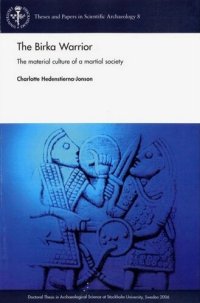
Ebook: The Birka Warrior: The Material Culture of a Martial Society
Author: Charlotte Hedenstierna-Jonson
- Genre: History // Archaeology
- Series: Theses and Papers in Scientific Archaeology 8
- Year: 2006
- Publisher: Stockholm University
- Language: English
- pdf
Doctoral Thesis in Archaeological Science 2006, Stockholm University.
This is a study of martial material culture in the context of the Viking Age warrior of Birka, Sweden. The aim is to establish the role, function and affiliation of the Birka warrior and thereby place Birka on the power-political map of the 10th century. The study is based on the excavations of the fortified structures, particularly the Garrison, at the trading post of Birka as well as the extensive remains of material culture deriving from these investigations. A starting hypothesis is that an analysis of material culture constitutes a way of mapping social structures and that style and iconography reflect cultural groups, contacts and loyalties.
Based on the case studies of six papers, the synthesis deals with questions of the work and world view of the warriors, as too their relation to their contemporary counterparts in eastern and western Europe. Questions are raised concerning the value and function of symbols in a martial context where material culture reflects rank, status and office. In defining the Birka warrior’s particular stylistic expression, a tool is created and used in the search for contacts and affiliations reflected through the distribution patterns. The results show close contacts with the eastern trading posts located on the rivers Volga and Dnjepr in Ancient Russia.
It is stated that these Rus’ trading posts, essentially inhabited by Northmen, shared a common cultural expression that was maintained throughout a vast area by exceptionally close contacts. It is suggested that a particular stylistic expression developed in these Rus’ trading places containing elements of mainly Scandinavian, Steppe nomadic and Byzantine origin.
In conclusion, the results of this thesis show that the warriors from Birka’s Garrison had a share in the martial development of contemporary Europe but with their own particular traits. Close relations with the eastern trade route and contact with the powerful Byzantine Empire were enjoyed. As a pointer for future research, it is wondered what organisational form the close-knit structure of the Rus’ trading posts actually took, keeping the subsequent guilds of medieval Europe in mind. The fall of the Garrison, as of Birka, corresponds with the establishment of Christianity in the region. Such changes were not limited to Central Sweden but part of a greater process where a new political structure was developing, better anchored in local concerns.
This is a study of martial material culture in the context of the Viking Age warrior of Birka, Sweden. The aim is to establish the role, function and affiliation of the Birka warrior and thereby place Birka on the power-political map of the 10th century. The study is based on the excavations of the fortified structures, particularly the Garrison, at the trading post of Birka as well as the extensive remains of material culture deriving from these investigations. A starting hypothesis is that an analysis of material culture constitutes a way of mapping social structures and that style and iconography reflect cultural groups, contacts and loyalties.
Based on the case studies of six papers, the synthesis deals with questions of the work and world view of the warriors, as too their relation to their contemporary counterparts in eastern and western Europe. Questions are raised concerning the value and function of symbols in a martial context where material culture reflects rank, status and office. In defining the Birka warrior’s particular stylistic expression, a tool is created and used in the search for contacts and affiliations reflected through the distribution patterns. The results show close contacts with the eastern trading posts located on the rivers Volga and Dnjepr in Ancient Russia.
It is stated that these Rus’ trading posts, essentially inhabited by Northmen, shared a common cultural expression that was maintained throughout a vast area by exceptionally close contacts. It is suggested that a particular stylistic expression developed in these Rus’ trading places containing elements of mainly Scandinavian, Steppe nomadic and Byzantine origin.
In conclusion, the results of this thesis show that the warriors from Birka’s Garrison had a share in the martial development of contemporary Europe but with their own particular traits. Close relations with the eastern trade route and contact with the powerful Byzantine Empire were enjoyed. As a pointer for future research, it is wondered what organisational form the close-knit structure of the Rus’ trading posts actually took, keeping the subsequent guilds of medieval Europe in mind. The fall of the Garrison, as of Birka, corresponds with the establishment of Christianity in the region. Such changes were not limited to Central Sweden but part of a greater process where a new political structure was developing, better anchored in local concerns.
Download the book The Birka Warrior: The Material Culture of a Martial Society for free or read online
Continue reading on any device:

Last viewed books
Related books
{related-news}
Comments (0)